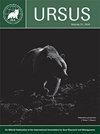伊朗北部人类与棕熊的冲突:对冲突管理的启示
IF 0.8
4区 生物学
Q4 ZOOLOGY
引用次数: 1
摘要
摘要:识别影响人类与野生动物冲突的因素以及人们对食肉动物的态度有助于管理者缓解冲突,改善野生动物管理。在这项研究中,我们使用问卷调查并进行了230次访谈,以评估2009年至2019年伊朗北部阿尔博尔斯山脉马赞达兰省当地社区与棕熊(Ursus arctos)之间冲突的某些方面。调查问卷的变量包括年龄、教育水平、职业、收入来源以及对农业财产、牲畜和蜂箱的攻击和破坏经历。44%的受访者报告棕熊对果园的破坏,32%的受访者报告棕熊对蜂巢的破坏;这些是主要的冲突原因。棕熊袭击人类的事件发生在人类打猎、放羊和采集药用植物的时候。约30%的受访者反对熊在自然界的存在,因为熊给他们造成了经济损失,人们对捕食者的态度主要受经济因素的影响。了解人类与棕熊冲突的不同模式有助于减少危险相遇,因此对该地区的冲突缓解措施提供信息至关重要。此外,关于棕熊行为的教育计划和补偿方法的实施可以减少人类与棕熊的冲突。本文章由计算机程序翻译,如有差异,请以英文原文为准。
Human–brown bear conflicts in the North of Iran: Implication for conflict management
Abstract: Identifying factors that influence human–wildlife conflict and people's attitudes toward carnivores can help managers mitigate conflicts and improve wildlife management. In this study, we used a questionnaire and conducted 230 interviews to evaluate some aspects of conflicts between local communities and brown bears (Ursus arctos) in Mazandaran Province in the Alborz Mountains in northern Iran between 2009 and 2019. The questionnaire included the variables age group, education level, occupation, and source of income as well as experience with attacks and damage to agricultural properties, livestock, and beehives. Damage by brown bears to orchards was reported by 44% of respondents and to beehives by 32%; these were the main conflict causes. Brown bear attacks on humans occurred while humans were hunting, sheepherding, and collecting medicinal plants. About 30% of respondents were opposed to the presence of bears in nature because of economic losses they suffered due to bears, and people's attitudes toward predators were mainly influenced by economic factors. Understanding different patterns of human–brown bear conflicts can help reduce dangerous encounters and, consequently, is essential for informing conflict mitigation measures in the area. Moreover, education programs on brown bear behavior and implementation of compensation methods can reduce human–brown bear conflicts.
求助全文
通过发布文献求助,成功后即可免费获取论文全文。
去求助
来源期刊

Ursus
生物-动物学
CiteScore
2.00
自引率
15.40%
发文量
12
审稿时长
>12 weeks
期刊介绍:
Ursus includes a variety of articles on all aspects of bear management and research worldwide. Original manuscripts are welcome. In addition to manuscripts reporting original research, submissions may be based on thoughtful review and synthesis of previously-reported information, innovative philosophies and opinions, and public policy or legal aspects of wildlife conservation. Notes of general interest are also welcome. Invited manuscripts will be clearly identified, but will still be subject to peer review. All manuscripts must be in English. All manuscripts are peer-reviewed, and subject to rigorous editorial standards.
 求助内容:
求助内容: 应助结果提醒方式:
应助结果提醒方式:


